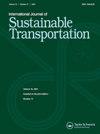交通和休闲步行对健康和生活满意度的影响
IF 3.1
3区 工程技术
Q2 ENVIRONMENTAL STUDIES
International Journal of Sustainable Transportation
Pub Date : 2025-03-04
DOI:10.1080/15568318.2025.2462161
引用次数: 0
摘要
研究调查了幸福感与步行和建筑环境的关系。然而,很少有研究区分环境步行性对交通和娱乐对幸福感的影响。因此,本研究分别确定了交通和娱乐的感知环境步行性(PEW),并研究了它们与健康状况和生活满意度的关系。本研究以300名台湾居民为对象,采用面对面问卷调查的方式收集资料。采用结构方程模型检验PEW、交通和休闲步行、身体质量指数、健康和生活满意度之间的关系,并纳入社会经济影响。结果表明,对土地利用混合通道和街道连通性的看法反映了交通方面的PEW,而对美学、土地利用混合多样性和步行设施这两个因素的看法反映了娱乐方面的PEW。交通步行与幸福感无关,但休闲步行与更高的健康和生活满意度有关。此外,较高的身体质量指数和较低的健康和生活满意度与拥有汽车有关。基于研究结果,改善幸福感的政策应该通过提高土地利用的可及性和多样性、街道连通性、美学和步行设施,促进休闲步行,而不是仅仅关注交通步行。本文章由计算机程序翻译,如有差异,请以英文原文为准。
Impacts of transport and recreational walkability on health and life satisfaction
Research has investigated well-being relationships to walking and built environments. However, few studies have differentiated the impacts of environment walkability for transport and recreation on well-being. Therefore, this study identified perceived environment walkability (PEW) for transport and recreation separately and examined their associations with health status and life satisfaction. Data were collected from 300 residents in Taiwan by face-to-face questionnaire interviews. Structural equation modeling was used to examine the relationship between PEW, transport and recreational walking, body mass index, and health and life satisfaction, incorporating socioeconomic influences. Results indicated that perceptions of land use mix-access and street connectivity reflected PEW for transport, whereas perceptions of the two factors, aesthetics, land use mix-diversity, and walking facilities reflected PEW for recreation. Transport walking was not associated with well-being, but recreational walking was associated with higher health and life satisfaction. Moreover, higher BMI and lower health and life satisfaction were associated with car ownership. Based on the findings, policies for well-being improvement should promote recreational walking, instead of focusing solely on transport walking, by enhancing land use access and diversity, street connectivity, aesthetics, and walking facilities.
求助全文
通过发布文献求助,成功后即可免费获取论文全文。
去求助
来源期刊
CiteScore
8.90
自引率
2.60%
发文量
56
期刊介绍:
The International Journal of Sustainable Transportation provides a discussion forum for the exchange of new and innovative ideas on sustainable transportation research in the context of environmental, economical, social, and engineering aspects, as well as current and future interactions of transportation systems and other urban subsystems. The scope includes the examination of overall sustainability of any transportation system, including its infrastructure, vehicle, operation, and maintenance; the integration of social science disciplines, engineering, and information technology with transportation; the understanding of the comparative aspects of different transportation systems from a global perspective; qualitative and quantitative transportation studies; and case studies, surveys, and expository papers in an international or local context. Equal emphasis is placed on the problems of sustainable transportation that are associated with passenger and freight transportation modes in both industrialized and non-industrialized areas. All submitted manuscripts are subject to initial evaluation by the Editors and, if found suitable for further consideration, to peer review by independent, anonymous expert reviewers. All peer review is single-blind. Submissions are made online via ScholarOne Manuscripts.

 求助内容:
求助内容: 应助结果提醒方式:
应助结果提醒方式:


